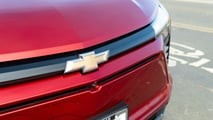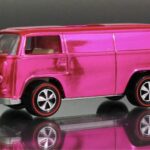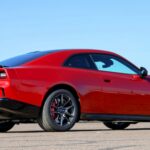After six months and 1,200 miles behind the wheel of the 2024 Chevrolet Blazer EV LT AWD, it’s time for an in-depth review. My journey, which included a road trip from San Diego to Utah, wasn’t always smooth, but it provided valuable insights into the realities of living with this electric SUV. There were moments of frustration, like having to turn back from a scenic overlook in Bryce Canyon due to range anxiety, even though the Blazer EV ultimately proved it could have made it. This experience perfectly encapsulates the duality of owning this EV: a blend of impressive features and areas needing improvement.
What Makes the Blazer EV Great?
Everyday driving in the Blazer EV is a genuine pleasure. My LT AWD model, similar to today’s 2LT trim, offers a refined and quiet ride, enhanced by excellent software integration. The spaciousness is another significant advantage. For our road trip, the Blazer EV swallowed camping gear, coolers, and luggage for two without complaint. We even slept comfortably in the back, proving its practicality for adventurous owners.
 Chevrolet Blazer EV LT radiant red exterior front view
Chevrolet Blazer EV LT radiant red exterior front view
Image: Front three-quarter view of a red 2024 Chevrolet Blazer EV LT, highlighting its modern design and road presence.
The built-in Google Maps is a standout feature. It eliminates the need for phone-based navigation systems like Apple CarPlay, offering seamless and reliable guidance. This integration extends to other apps like Spotify, allowing phone-free errands without losing essential connectivity and entertainment.
Ground clearance is another unexpected highlight. With 7.9 inches of clearance, the Blazer EV surpasses many mainstream electric SUVs, including the Hyundai Ioniq 5 and Kia EV6. Even Jeep’s first electric SUV offering falls short. This, combined with its generous cargo space and roomy rear seats, positions the Blazer EV as an ideal electric vehicle for those who need to haul passengers and gear, venturing beyond paved roads for camping or hiking trips. While not a dedicated off-roader, its capabilities exceed typical EV expectations in this segment.
 Chevrolet Blazer EV ground clearance on dirt road
Chevrolet Blazer EV ground clearance on dirt road
Image: Side profile of the Chevy Blazer EV showcasing its ground clearance while parked on a dirt road, emphasizing its suitability for light off-road adventures.
For those seeking even more rugged electric options, Rivian and electric pickups exist, but they come at a significantly higher price point. The Blazer EV strikes a compelling balance between capability and affordability.
Where the Blazer EV Is Just Fine
The EPA-estimated range of 279 miles for my Blazer EV LT AWD is adequate for its class, but road trips reveal its limitations. Real-world use means rarely depleting the battery to zero or charging to 100%. The Blazer EV’s range prediction tends to be conservative, often leading to charging stops with around 20% battery remaining. Considering slower charging speeds above 80%, effectively only about 60% of the battery capacity is practically utilized for road trips. This translates to roughly 160-180 miles between charges, with charging stops averaging around 35 minutes.
 Chevrolet Blazer EV charging station waiting line
Chevrolet Blazer EV charging station waiting line
Image: A line of electric vehicles waiting to use a charging station, illustrating the potential wait times and infrastructure challenges during EV road trips.
While acceptable, this range highlights the desire for closer to 350 miles of EPA range for frequent road trippers. However, for daily commutes and less frequent long journeys, the range is comparable to other AWD EVs like the Kia EV6 and Hyundai Ioniq 5. A higher-range, rear-wheel-drive Blazer EV version is available for those prioritizing maximum range. The silver lining of more frequent stops is arriving at destinations feeling refreshed, compared to enduring long, non-stop drives.
Driving dynamics are satisfactory but not exhilarating. The Blazer EV is a substantial crossover, prioritizing comfort over sporty handling. Its 288-horsepower powertrain with 333 lb-ft of torque provides ample punch for daily driving, offering brisk acceleration from a standstill. However, its 5,300-lb weight becomes apparent when pushing harder, limiting its agility. Handling is competent for its size, better than a Toyota RAV4 or Ford Escape, but it’s not designed for spirited driving.
Similarly, the sound system and seats are adequate. The Blazer EV offers a quiet and smooth highway ride, but the standard speakers and seats are unremarkable. While the seats were sufficient for a 1,200-mile trip, those seeking a more luxurious experience might find them lacking compared to premium EVs.
The Frustrating Aspects of the Blazer EV
The MyChevrolet smartphone app is a significant pain point. Slow response times, often taking close to a minute to update the state of charge, and unreliable remote start commands plague the user experience. Workarounds like sending a lock command first or using the MyBuick app offer marginal improvements, but the app remains clunky and far behind the intuitive and responsive apps from competitors like Tesla.
Tesla Supercharger access, while a welcome addition for GM EVs, is hampered by the MyChevrolet app’s limitations. While GM supports Supercharger access through the app, the native Tesla app is significantly more reliable and user-friendly. Unlike Rivian and Ford, GM EVs lack seamless automatic payment and charge initiation at Tesla Superchargers, adding unnecessary steps and potential frustration.
 Chevrolet Blazer EV LT radiant red exterior front view
Chevrolet Blazer EV LT radiant red exterior front view
Image: A Chevrolet Blazer EV awkwardly parked across two Tesla Supercharger stalls, illustrating the challenges of using Tesla’s charging infrastructure with non-Tesla EVs due to cable length and stall design.
The physical charging experience at Tesla Superchargers can be awkward. The shorter cable length often necessitates parking across multiple stalls or even partially off-pavement, a less-than-ideal user experience, though not GM’s fault directly, but a consequence of Tesla’s infrastructure design. Newer V4 Superchargers with longer cables offer a glimpse into a more user-friendly future, but the current reality can be inconvenient.
Charging times themselves are also on the longer side. Even on a 350-kW charger, a 10-80% charge can take 40 minutes under optimal conditions. Winter range is another concern. Cold temperatures and elevation gains significantly impact efficiency, as demonstrated during the Bryce Canyon trip. Rural road trips in cold climates necessitate factoring in substantial range reduction.
Finally, quality control issues are evident. A persistent rattle from the headliner, despite a replacement attempt, and a temperamental panoramic moonroof requiring multiple attempts to close, point to areas where GM needs to improve manufacturing consistency. These issues have already resulted in multiple dealer service appointments within the first six months of ownership.
 Chevrolet Blazer EV ground clearance on dirt road
Chevrolet Blazer EV ground clearance on dirt road
Image: Chevrolet Blazer EV successfully charging at a Tesla Supercharger station, showcasing the potential for convenient charging despite current limitations and workarounds.
My Verdict on the Chevrolet Blazer EV So Far
Despite its drawbacks, I remain largely satisfied with the Blazer EV, primarily due to its value proposition. The lease deal makes it an affordable entry point into the EV SUV segment. The ownership experience isn’t flawless, demanding more planning and adaptation than a comparable Tesla. Adapters, third-party route planners, and potential quality niggles are part of the equation.
However, the Blazer EV delivers on its core promises: a comfortable, stylish, and highly practical SUV at a competitive price. It represents a learning curve in adapting to EV ownership, shifting away from traditional gasoline car expectations. It underscores that while GM is making strides in the EV market, software, charging infrastructure integration, and consistent quality remain critical areas for improvement.
Yet, the Blazer EV’s advantages are undeniable. Lower running costs, a quieter and smoother ride, and modern in-car technology make it a compelling option. It signals that EV ownership, even in its current iteration, is “pretty damn good” and poised to become even better. Embracing EV ownership with a sense of curiosity, flexibility, and a willingness to improvise leads to an enjoyable and forward-looking driving experience. The Chevrolet Blazer EV, with its mix of strengths and weaknesses, is a significant step in that electric adventure.

